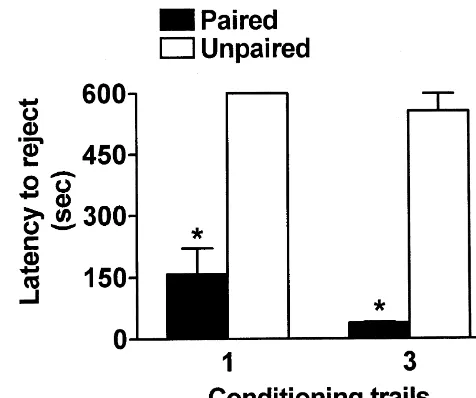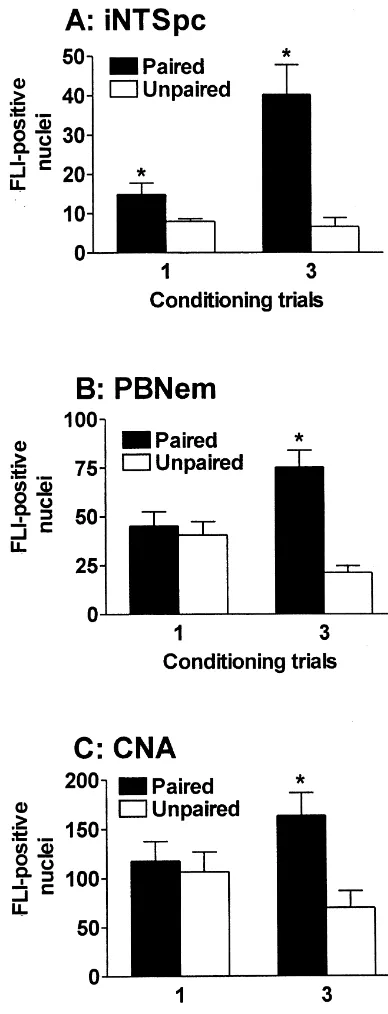Brain Research 887 (2000) 450–453
www.elsevier.com / locate / bres
Short communication
cFos induction during conditioned taste aversion expression varies
with aversion strength
a,b a,b a,b a,b
Montserrat Navarro
, Kristina J. Spray
, Inmaculada Cubero
, Todd E. Thiele
,
a,b ,
*
Ilene L. Bernstein
a
Department of Psychology, University of Washington, 119 Guthrie Hall, Box 351525, Seattle, WA 98195-1525, USA
b
Departmento de Psicologia Experimental y Psicobiologia, University of Almeria, Almeria 04120, Spain Accepted 19 September 2000
Abstract
Fos-like immunoreactivity (FLI) can indicate the location of neurons activated following expression of conditioned taste aversion (CTA). After one conditioning trial FLI has been identified in the intermediate nucleus of the solitary tract (iNTS) with little expression in other brain regions. The present study assessed the effect of increasing aversion strength on the magnitude and anatomical distribution of FLI during CTA expression. When animals received three rather than one conditioning trial, significant FLI was seen not only in the iNTS but also in the parabrachial nucleus (PBN), and the central nucleus of the amygdala (CNA), regions thought to be important in taste aversion learning. 2000 Elsevier Science B.V. All rights reserved.
Theme: Neural basis of behavior
Topic: Learning and memory: systems and functions
Keywords: Nucleus tractus solitarius; c-Fos; Learning; Lithium chloride; Aversion conditioning; Amygdala, Pontine parabrachial nucleus
Taste aversion conditioning is a form of learning expression was assessed by comparing animals that re-distinguished by its rapid acquisition, tolerance of long ceived either one or three conditioning trials.
delays between conditioned stimulus (CS) and uncon- Male Long–Evans rats weighing between 300 and 400 g ditioned stimulus (US) and clear survival value [1,3]. A were individually housed in stainless steel cages and localized and conditioning-specific elevation in fos-like maintained on a 12:12 h light:dark cycle. Food and water immunoreactivity (FLI) has been identified in brainstem were provided ad libitum. Animals were implanted with neurons during the expression of a conditioned taste intraoral cannulae constructed of PE-100 tubing as previ-aversion (CTA) [6,14]. Prior to conditioning the CS, an ously described [11].
intraoral infusion of saccharin solution, was not associated After recovery from surgery animals were habituated to with increases in FLI in the intermediate nucleus of the Plexiglas observation chambers. Rats were assigned to solitary tract (iNTS) [14]. After a single conditioning trial groups (n56 per group): one trial-paired; one trial-un-FLI was evident in the iNTS but not in other brain regions paired; three trials-paired and three trials-unpaired. A known to be important for this learning [e.g. parabrachial conditioning trial consisted of I / O delivery of 5 ml of nucleus (PBN); amygdala] although other laboratories 0.15% saccharin infused at a rate of 0.5 ml / min followed suggest that the anatomical distribution of Fos induction immediately by injection of 0.15 M LiCl (20 ml / kg i.p) in during CTA expression may be wider [5,15]. In the present paired groups or an equivalent volume of 0.15 M NaCl in study the effect of increasing aversion strength on the unpaired groups. The day after each conditioning trial magnitude and anatomical distribution of FLI during CTA paired animals received non-contingent injections of 0.15 M NaCl, while unpaired animals received non-contingent injections of 0.15 M LiCl.
*Corresponding author. Tel.: 11-206-543-4527; fax: 1
1-206-685-Three days after the last conditioning day, rats were
3157.
E-mail address: [email protected] (I.L. Bernstein). tested by re-exposure to the CS taste. The animals’
M. Navarro et al. / Brain Research 887 (2000) 450 –453 451
responses to the CS were videotaped for later assessment of rejection responses. Two h later, rats were deeply anesthetized with sodium pentobarbital and transcardially perfused with isotonic PBS followed by 4% paraformal-dehyde in 0.1 M PB. The brains were removed and postfixed for 24–48 h in 4% paraformaldehyde.
Brains were cut into medullary, ponto-midbrain, and forebrain blocks, and sectioned in the transverse plane at 50 mm on a vibratome. Slices were rinsed (33, PBS), incubated for 20 min in 0.3% H O in absolute methanol2 2 to quench endogenous peroxidase, rinsed (33, PBS), and incubated for 1 h in 1% gelatin, 3% normal goat serum in PBS. Slices were then transferred without rinsing to the primary antibody solution, which consisted of 1:20,000 c-fos polyclonal rabbit IgG (Santa Cruz Biotechnology, Santa Cruz, CA) which recognizes residues 3–16 of the Fos protein. After a 36 h incubation at 48C, slices were rinsed (103, PBS, 1 h) and processed using the standard
Fig. 1. Mean (6S.E.M.) latency to reject intraorally infused saccharin
ABC method (Vector Laboratories, Burlingame, CA). solution during testing following either one or three conditioning trials. FLI positive cells within intermediate iNTS, PBN and Solid bars represent subjects that received saccharin and LiCl paired; open bars represent subjects that received saccharin and LiCl unpaired.
amygdala subnuclei were plotted blindly. FLI counts were
*P,0.05 Paired vs. Unpaired. One trial-paired vs. Three trial-paired:
based on a single representative section per region for each
P,0.05.
animal and numbers represent the sum from both sides of the brain. FLI-positive neurons were defined as cells with
nuclei in which the solid reaction product covered at least 18.12, P50.001] and a significant interaction [F(1, 20)5
half of the nucleus. 12.82, P50.002]. Post hoc tests confirmed that there was
Videotapes were viewed and scored blind. Rejection significant induction of FLI by the CS-taste only in the latency was defined as the time elapsing between onset of paired group receiving three conditioning trials. Paired the I / O infusion and the onset of persistent dripping of the groups did not differ significantly from each other.
solution. FLI in Amygdala. Damage to some brain tissue
en-Data were analyzed with two-way, 232 (Pairing3 compassing amygdala reduced n to 4 in both unpaired Trials) ANOVA. When significant differences were found, groups and to 5 in the one trial-paired group. Significant post-hoc analyses were conducted using Tukey’s HSD. A induction of FLI by the CS-taste was observed in the standard level of P,0.05 (two-tailed) was used for central (CNA), but not the basolateral, nucleus of the
statistical significance. amygdala and this was seen only in paired animals that
On the test day, both paired groups demonstrated received three conditioning trials (Fig. 2C). ANOVA significant aversions. Compared to unpaired controls, yielded a significant effect of pairing [F(1, 15)55.88, paired animals rejected saccharin earlier in the test session P50.028] and post hoc tests confirmed that only the paired (Fig. 1). Three pairings produced significantly stronger group receiving three conditioning trials showed significant CTAs. ANOVA performed on the data yielded a significant FLI. Paired groups did not differ significantly from each effect of pairing [F(1, 20)5155.4, P50.001] and trials other.
452 M. Navarro et al. / Brain Research 887 (2000) 450 –453
[11]. In addition, our methodology was not expected to be sensitive to all levels of neural activity. Rather, it is a known limitation of FLI as an index of neuronal activity that the absence of cFos induction can not be taken to indicate the absence of neuronal activation [2,8,12]. Since measurable elevations of FLI are a relatively high thres-hold index of neuronal activation, it is likely that PBN and amygdala were activated in the one trial group as well, but the level of activation did not reach the threshold for induction of detectable cFos.
The regions in which FLI is elevated are known to be important for CTA acquisition and / or expression [1,9,10,15]. Bilateral lesions of amygdala disrupt both the acquisition and behavioral expression of a CTA, as well as the associated elevations in FLI in iNTS [9,11]. Further-more, unilateral amygdala lesions block cFos induction in iNTS ipsilateral to the lesion even though unilateral lesions do not block the behavioral expression of aversions [11]. This suggests that an ipsilateral pathway from amygdala to iNTS is critical for the conditioned FLI which occurs there during expression of a CTA. FLI in CNA after three conditioning trials could indicate the strong activation of cells in amygdala responsible for FLI in iNTS. It is tempting to speculate that the regions displaying FLI during CTA expression mark key parts of the output circuit for CTA learning. In this context the FLI in PBN is somewhat harder to interpret. Although lesions of PBN interfere with the ability to acquire a CTA [10,13], an intact PBN doesn’t appear to be necessary for expression of a CTA acquired prior to lesioning [4]. This implies that the neural circuit responsible for CTA expression does not depend on the PBN. Nonetheless, FLI in PBN during CTA expression points to a population of cells in PBN which is strongly activated during CTA expression. Thus, although PBN may not be necessary for behavioral CTA expression, it appears highly responsive during CS taste exposure and it may play a direct or indirect role in the FLI in iNTS.
Acknowledgements
This research was supported by NIH Grant NS37040.
Fig. 2. Mean (6S.E.M.) number of nuclei positive for FLI in the (A) parvicellular subnucleus of the intermediate NTS (iNTSpc) One
trial-paired vs. Three trial-trial-paired: P,0.05; (B) external medial region of the References PBN (PBNem) One trial-paired vs. Three trial-paired: ns; (C) central
nucleus of the amygdala (CNA) One trial-paired vs. Three trial-paired: ns.
[1] I.L. Bernstein, Flavor aversion, in: T.V. Getchell, R.L. Doty, L.M. *P,0.05 relative to the Unpaired group.
Bartoshuk, J.B. Snow (Eds.), Smell and Taste in Health and Disease, Raven Press, New York, 1991, pp. 417–428.
[2] M. Dragunow, R. Faull, The use of c-fos as a metabolic marker in
differential involvement of these regions in strong versus neuronal pathway tracing, J. Neurosci. Methods 29 (1989) 261–265. [3] J. Garcia, W.G. Hankins, K.W. Rusiniak, Behavioral regulation of the
weak aversion conditioning. However, there are several
milieu interne in man and rat, Science 185 (1974) 824–831.
reasons why we believe this is not the most likely
[4] P.S. Grigson, T. Shimura, R. Norgren, Brainstem lesions and
interpretation of these data. First, at least in the case of gustatory function: III The role of nucleus of the solitary tract and amygdala, lesion data support the involvement of the parabrachial nucleus in the retention of a conditioned taste
M. Navarro et al. / Brain Research 887 (2000) 450 –453 453 [5] T.A. Houpt, R.A. Berlin, G.P. Smith, Altered induction of c-Fos in [10] S. Reilly, The parabrachial nucleus and conditioned taste aversion,
the central nucleus of the amygdala (CeN) correlated with con- Brain Res. Bull. 48 (1999) 239–254.
ditioned taste aversion expression, Neurosci. Abstr. 21 (1995) 1682. [11] G.E. Schafe, I.L. Bernstein, Forebrain contribution to the induction [6] T.A. Houpt, J.M. Philopena, T.C. Wessel, T.H. Joh, G.P. Smith, of a brainstem correlate of conditioned taste aversion: I. The
Increase expression of c-fos in nucleus of the solitary tract corre- amygdala, Brain Res. 741 (1996) 109–116.
lated with conditioned taste aversion to sucrose in rats, Neurosci. [12] M. Sheng, M.E. Greenberg, The regulation and function of c-fos and Lett. 172 (1994) 1–5. other immediate early genes in the nervous system, Neuron 4 (1990) [7] N.J. Mackintosh, The Psychology of Animal Learning, Academic 477–485.
Press, New York, 1974. [13] A.C. Spector, R. Norgren, H.J. Grill, Parabrachial gustatory lesions [8] J.I. Morgan, T. Curran, Stimulus-transcription coupling in the impair taste aversion learning in rats, Behav. Neurosci. 106 (1992)
nervous system: Involvement of the inducible proto-oncogenes fos 147–161.
and jun, Ann. Rev. Neurosci. 14 (1991) 421–451. [14] M.W. Swank, I.L. Bernstein, cFos induction in response to a [9] R. Morris, S. Grey, T. Kasambira, M. Petrides, Ibotenic acid lesions conditioned stimulus after single trial taste aversion learning, Brain
of the basolateral, but not the central amygdala intere with con- Res. 636 (1994) 202–208.
ditioned taste aversion: Evidence from a combined behavioral and [15] T. Yamamoto, Neural mechanisms of taste aversion learning, anatomical tract-tracing investigation, Behav. Neurosci. 113 (1999) Neurosci. Res. 16 (1993) 181–185.

